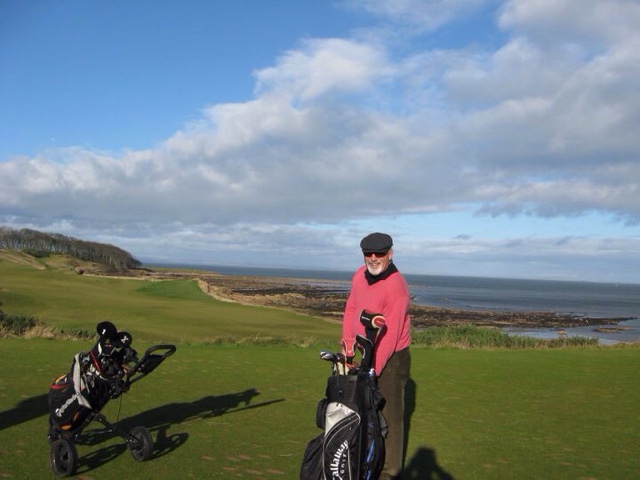There is only one absolute in golf that I can think of after fifty years of playing the game. There are some good fundamentals regarding the swing that, if followed, will tend to make the game easier to play--like a still head, a firm left arm, a sound grip, and a one-piece takeaway--but there have been good, and even great, players who have swings that don't follow all the rules.
The one absolute is that a club face that is aimed at the target and is moving down the target line will produce a straight shot. Even that is not absolutely true, I suppose, when you factor in the effect of wind, or mud on the ball. But that's about as absolute as it gets in this game. The key for every golfer is to find the best way for you to swing the club to produce a square strike with the club moving down the target line. And that is only if you are attempting to play a sraight shot, which Ben Hogan and Jack Nicklaus considered to be more good luck than good management. Neither Hogan or Nicklaus ever tried to hit a full shot straight. But that's another story.
The truth is, however, that the only thing that determines the flight and direction of the ball--other than wind and/or mud on the ball--is the path and angle of the club face at impact. You can make the prettiest swing ever and still miss the shot if, at the moment of truth, your club face isn't moving in the right direction and facing the right way. That's why Bobby Jones wrote a chapter on striking the ball that he said was the most important knowledge any golfer can learn. Learning the iron-clad, scientific truth about how a ball will respond when struck different ways is the key to understanding the game.
I was reading Jack Nicklaus' book, Golf My Way, and near the beginning, Jack provides the same information. Like Bobby Jones, Jack learned these things through endless hours of playing and practising the game as a kid. The fact is, however, understanding these things as early as possible when learning the game, or finally understanding these things after you have struggled with your game, can really turn you into a better player overnight. Bobby Jones strongly believed this.
So, without further ado, if you don't already know why you are slicing the ball, or pulling it, or hitting snap hooks, Jack Nicklaus provides the real answer. By understanding this information, you just might see more shots going where you want them to. And, even if they don't, at least you'll know why the ball reacted as it did. Jack wrote:
"What causes this sidespin? The simple answer is any kind of glancing or crosscutting blow. And what causes a glancing or crosscutting blow? No, it isn't the fact that you didn't turn enough going back or failed to start the downswing with your legs. What's more, it isn't necessarily what you've come to believe from reading other golf books: that an inside-out swing always causes a hook, or that an outside-in swing always produces a slice. At root is the fact that, at impact, your clubface was not looking in the same direction as your clubhead was travelling.
To make this clearer yet, let's specifically relate the interaction of clubface alignment and swing path to the curve balls and foul balls you actually hit on the course:
WHEN YOU SLICE. Your clubface is looking right of the direction in which your clubhead is moving. Thus you cut across the ball from out to in, imparting left-to-right sidespin to the ball.
WHEN YOU FADE. The same cross-cutting action as above, only the angle between your clubface and swing path is smaller.
WHEN YOU HOOK. Your clubface is looking left of the direction in which your clubhead is moving. Thus you cut across the ball from in to out, imparting right-to-left sidespin to the ball.
WHEN YOU DRAW. Same crosscutting action as when you hook, only the angle between your clubface and swing path is smaller.
WHEN YOU PULL STRAIGHT LEFT. Your clubface is looking in the same direction as the clubhead is travelling. The trouble is you're swinging from out to in. (Consequently, a golfer who hits straight left should not think of himself as a hooker, but recognize that he actually has a slicer's fault--an out-to-in swing path.)
WHEN YOU PUSH STRAIGHT RIGHT. Your clubface is looking in the same direction as your clubhead is travelling. The problem is you are swinging from in to out across your target line. (Thus, although the ball ends up to the right, like a slicer's, you are actually swinging on a hooker's path.)
WHEN YOU PULL-HOOK ( the ball starts left and curves more left). Your clubhead is travelling from out to in, across the target line, with the clubhead looking left of the swing path.
WHEN YOU PUSH-SLICE ( the ball starts right and curves more right). The clubhead is travelling from in to out, across the target line, with the clubface looking right of the swing path.
Elementary? To a good player, probably. To a high handicapper, I'm not so sure. Either way, the basic point may be worth restating: It helps to know where--and how-- you want to go before you start going there."
Bobby Jones made the same point, going on to say that every golfer needed to understand the relationship between swingpath and clubface angle, and the resulting shot shapes that can result. He then said that by focussing on the strike required, a golfer could come to understand what was causing the different shots, and how to set himself and swing the club to correct the situation, or to intentionally produce a draw, or a fade, or a hook.
It is science. But it isn't rocket science.




















